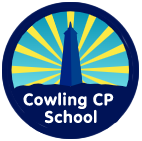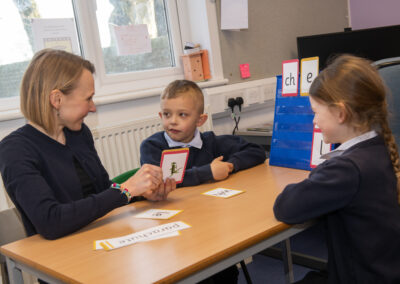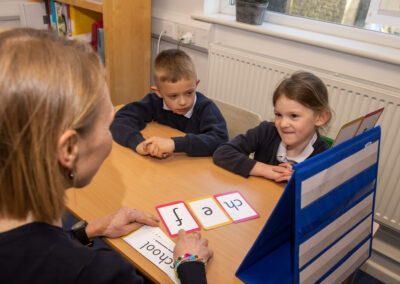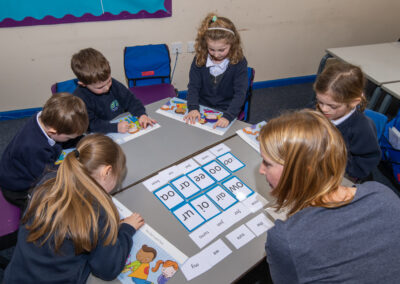Early Reading and Phonics Curriculum Lead: Mrs Abby Amos
Intent: At Cowling Primary School we believe that reading is the key to success. We also understand how:
‘Reading for pleasure is the single most important indicator of a child’s future success.’ (OECD 2002) and ‘The will influences the skill and vice versa.’ (OECD 2010)
Our vision is for all our children to:
- become engaged with reading from the beginning
- read easily, fluently and with good understanding
- develop the habit of reading widely and often, for both pleasure and purpose
By the end of their primary education, we aim for all pupils to be able to read fluently, and with confidence, in any subject in their forthcoming secondary education.
Implementation: At Cowling Community Primary School we teach reading through Little Wandle Letters and Sounds Revised. We start teaching phonics in Reception and follow the Little Wandle Letters and Sounds Revised progression, which ensures children build on their growing knowledge of the alphabetic code, mastering phonics to read and spell as they move through school. We also model the application of the alphabetic code through phonics in shared reading and writing, both inside and outside of the phonics lesson and across the curriculum.
Daily phonics lessons in Reception and Year 1:
We teach phonics for 30 minutes a day. In Reception, we build from 10-minute lessons, with additional daily oral blending games, to the full-length lesson as quickly as possible. Each Friday, we review the week’s teaching to help children become fluent readers. Children make a strong start in Reception: teaching begins in week 2 of the Autumn term. We follow the Little Wandle Letters and Sounds Revised ambitious expectations of progress.
Teaching reading: Reading practice sessions three times a week:
We teach children to read through reading practice sessions three times a week. These are taught by a fully trained adult to small groups of children and use books matched to the children’s secure phonic knowledge using the Little Wandle Letters and Sounds Revised assessments and book matching grids. Each reading practice session has a clear focus, so that the demands of the session so not overload the children’s working memory. The reading practice sessions have been designed to focus on three key reading skills:
– decoding
– prosody: teaching children to read with understanding and expression
– comprehension: teaching children to understand the text.
In Reception these sessions start in week 4. Children who are not yet decoding have daily additional blending practice in small groups, so that they quickly learn to blend and can begin to read books.
In Years 2 and above, we continue to teach reading in this way for any children who still need to practise reading with decodable books.
Keep-up lessons and Rapid Catch-up lessons ensure every child learns to read:
Any child in EYFS and Year 1 who needs additional practice has keep-up support, taught by a fully trained adult. We use the Little Wandle Letters and Sounds Revised assessments to identify the gaps in their phonic knowledge and teach to these using the keep-up resources. We reassess these children approximately every 3 weeks.
We timetable additional phonics lessons for any child in Year 2 and above who is not yet fully fluent at reading or has not passed the Phonics screening check. These children urgently need to catch up, so the gap between themselves and their peers does not widen. We use the Rapid Catch-up assessments to identify the gaps in their phonic knowledge and teach to these using the Rapid Catch-up resources – at pace.
Little Wandle Rapid Catch-up is a complete catch-up programme that mirrors the main phonics programme but has a faster pace. It has been created to help children catch up quickly.
Home reading:
The decodable reading practice book is taken home to ensure success is shared with the family. These books align perfectly to the Little Wandle Letters and Sounds Revised programme. They are read during our reading practice sessions and then taken home to ensure success is shared with the family. Sharing books are also sent home for parents to share and read to their children. These books are chosen by the children from our reading areas. We also send out a weekly home learning sheet to our parents outlining what we have been learning that week allowing children to celebrate and reinforce their learning at home.
Ensuring consistency and pace of progress:
Every teacher in our school has been trained to teach reading, so we have the same expectations of progress. We all use the same language, routines and resources to teach children to read so that we lower children’s cognitive load.
Weekly content grids map each element of new learning to each day, week and term for the duration of the programme.
Lesson templates, Prompt cards and How to videos ensure teachers all have a consistent approach and structure for each lesson.
The Early Reading Leader uses the Little Wandle leadership resources to ensure fidelity to the Little Wandle programme.
Ensuring reading for pleasure:
We value reading for pleasure highly and work hard as a school to grow our Reading for Pleasure pedagogy.
We read to children every day.
Every classroom has an inviting book area that encourages a love for reading. The school library is made available for classes to use and we have reading ambassadors.
We take part in World Book Day and organise a visit from an author or illustrator annually.
Impact:
Assessment
Assessment is used to monitor progress and to identify any child needing additional support as soon as they need it.
Assessment for learning is used:
– daily within class to identify children needing support
– weekly in the Review lesson to assess gaps, address these immediately and secure fluency of GPCs, words and spellings.
Summative assessment for Reception and Year 1 is used:
– every six weeks to assess progress, to identify gaps in learning that need to be addressed, to identify any children needing additional support and to plan the Keep-up support that they need.
– by SLT and scrutinised through the Little Wandle Letters and Sounds Revised assessment tracker, to narrow attainment gaps between different groups of children and so that any additional support for teachers can be put into place.
Fluency assessments measure children’s accuracy and reading speed in short one-minute assessments. They are used:
– in Year 1, when children are reading the Phase 5 set 3, 4 and 5 books
– with children following the Rapid Catch-up programme in Years 2 to 6, when they are reading the Phase 5 set 3, 4 and 5 books
– to assess when children are ready to exit their programme. For Year 1 children, this is when they read the final fluency assessment at 60–70+ words per minute. Older children can exit the Rapid Catch-up programme when they read the final fluency assessment at 90+ words per minute. At these levels, children should have sufficient fluency to tackle any book at age-related expectations. After exiting their programme, children do not need to read any more fully decodable books.
A placement assessment is used:
– with any child new to the school in Reception and Year 1 to quickly identify any gaps in their phonic knowledge and plan and provide appropriate extra teaching.
Statutory assessment:
Children in Year 1 sit the Phonics screening check. Any child not passing the check re-sits it in Year 2.
Ongoing assessment for Rapid Catch-up in Years 2 to 6:
Children in Year 2 to 6 are assessed through:
– the Rapid Catch-up initial assessment to quickly identify any gaps in their phonic knowledge and plan appropriate teaching
– the Rapid Catch-up summative assessments to assess progress and inform teaching
– the Rapid Catch-up fluency assessments when children are reading the Phase 5 set 3, 4 and 5 books for age 7+.
The fluency assessments measure children’s accuracy and reading speed in short one-minute assessments. They also assess when children are ready to exit the Rapid Catch-up programme, which is when they read the final fluency assessment at 90+ words per minute.





